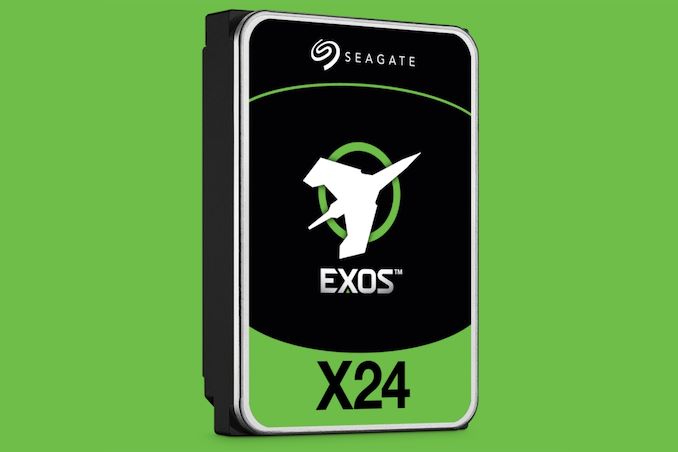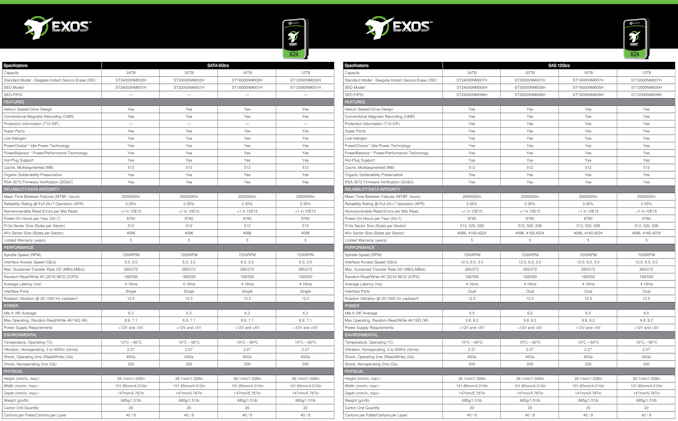Seagate Unveils Exos X24 24TB and 28 TB: Setting the Stage for HAMR HDDs
by Anton Shilov on October 19, 2023 11:00 AM EST
Seagate on Wednesday introduced its Exos X24 family of hard drives, it's highest capacity series of drives to date. The new family is comprised of both conventional magnetic recording technology (CMR) and shingled magnetic recording (SMR) models, with the CMR drive topping out at 24 TB, while SMR brings the peak capacity up to 28 TB. Both are, as of now, the highest-capacity HDDs in their respective segments. But perhaps the most important technological development with the Exos X24 lineup is that it uses a platform that will be largely re-used for the upcoming HAMR drives.
The Seagate Exos X24 3.5-inch helium-filled hard drive family includes 12 TB, 16 TB, 20 TB, and 24 TB models, which are built using up to 10 2.4 TB platters. Seagate's platters feature perpendicular magnetic recording (PMR) and heads utilizing two-dimensional magnetic recording (TDMR) technology (to minimize adjacent track interference and ensure reliable reading at high track pitch densities). In addition, Seagate offers a sole 28 TB SMR version of the Exos X24 to select cloud customers who can self-manage shingled recording in their datacenters.
Seagate's Exos X24 HDDs operate at a spindle speed of 7200 RPM and feature a segmented 256 MB cache (check out all of its specifications in tables below). The family's 2.4 TB platters have an areal density of 1260 Gbit/inch2, allowing for a peak sustained transfer rate of 285 MB/s, which is in line with previous-generation HDDs (which is a bit surprising as typically higher areal density enables higher transfer rates). The entire Exos X24 range offers up to 168/550 random read/write IOPS (4K, QD16), which is again in line with previous-generation drives.
Seagate plans to make the Exos X24 HDDs available with either a SATA 6 Gbps or a dual-port SAS 12 Gbps interface to cater to varying customer needs.
As for power consumption of Exos X24, it ranges from 6.3W (idle) to 8.9W (max) for SATA versions and from 6.5W (idle) to 9.8W (max) for the SAS SKUs. Exos X24 HDDs are also adaptable to meet the diverse needs of major clients, supporting PowerBalance technology, which offers data centers the ability to harmonize power usage with IOPS performance. Additionally, they feature PowerChoice technology, optimizing power consumption during periods of inactivity.
| Seagate Exos X24 - Metrics of Interest | |
| Rated Workload (TB/yr) | 550 |
| Max. Sustained Transfer Rate (MBps) | 285 |
| Random Read/Write 4K QD16 WCD (IOPS) | 168/550 |
| Areal Density | 1260 Gbit/inch2 |
| Rated Load / Unload Cycles | 600K |
| Unrecoverable Read Errors | 1 in 10E15 |
| MTBF (Hours) | 2.5M |
| Power (Idle / Active) (W) | SATA: 6.3W - 8.9W | SAS: 6.5W - 9.8W |
| Warranty (Years) | 5 |
| Datasheet | |
The enterprise-focused drives otherwise check all of the usual boxes for this market segment, including vibration resistance and RV sensors. The drives are rated to handle workloads up to 550 TB/year, with a 5 year overarching warranty.
Seagate said it had commenced shipping of qualification Exos X24 drives to select customers, and the production drives are slated to be widely available for channel distribution in December.
Finally, and most interesting of all, the company has also revealed that the 10-platter helium-sealed platform will be significantly re-used for the company's upcoming heat-assisted magnetic recording (HAMR) hard drives. Those drives will be available in capacities up to 32 TB, with Seagate set to ramp up production in early 2024.
Source: Seagate











15 Comments
View All Comments
Grebuloner - Thursday, October 19, 2023 - link
Only 256MB cache on a drive that large while 512MB is already in the wild?And it's time to up the TB/year rating. All the drives seem to max out at that figure. (~9PB is a 100% writes per year total)
PeachNCream - Thursday, October 19, 2023 - link
Don't forget that main memory is more than adequate as a cache for mechanical drives and the underlying technologies have improved significantly over the years as DRAMless SSDs have demanded using system RAM to prop up performance.rtho782 - Monday, November 6, 2023 - link
Strangely the datasheet at the bottom says 512mb.wrosecrans - Thursday, October 19, 2023 - link
20+ years later, Ultra SCSI 320 is still more than fast enough for any one mechanical hard drive. Yeah yeah, I know it was always meant for multi disk arrays on a shared bus and not just a single drive. But still, it would have shocked us 25 years ago to see how much some technologies have stagnated. It's amazing hard drives are still relevant despite all the growing pains they've had with a Million x capacity growth. It really feels like we may be finally close to the end of the line with cheap flash only being ~2x the price of expensive rust. Once they hit price parity, it's pretty much over for rust going in circles.nandnandnand - Thursday, October 19, 2023 - link
NAND is great when you want to be able to shake it and not have a head crash. Not so great for cold storage with QLC taking over and PLC waiting in the wings.Threska - Thursday, October 19, 2023 - link
Maybe FeFET memory will be the solution.https://onlinelibrary.wiley.com/doi/10.1002/advs.2...
The Von Matrices - Thursday, October 19, 2023 - link
HDDs always seem to be one step ahead of flash in terms of capacity per price, and they will continue to be. If HAMR disks actually do come out, then hard drive capacities will double to 48TB within the next year or two for only a modest increase in price, and they will continue to be the go-to method for cheap storage.As far as transfer rate, that's just a consequence of geometry. Data density increases in three dimensions (radial density, angular density, number of platters) but transfer rate only scales with one dimension (angular density) so drives will always get slower and slower relative to their capacity over time.
PeachNCream - Thursday, October 19, 2023 - link
This is why we need to being back the Quantum Bigfoot 5.25 inch hard drive! May as well use all those empty ROM drive bays in old cases that still have them for storing your huge collection of ... Linux ISOs.Bob Todd - Friday, October 20, 2023 - link
I can buy a new X16 16TB Exos CMR drive from B&H right now for $300. Please show me where I can buy a 16TB SSD for $600. People always post this "spinning rust is almost dead, flash is only 2x the price" garbage but it's never true.meacupla - Friday, October 20, 2023 - link
best I can find is 2TB for $80ish and 4TB for $200ish